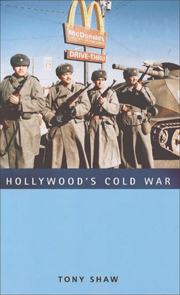Book contents
- Frontmatter
- Contents
- Acknowledgements
- List of Abbreviations
- Introduction
- 1 Love and defection
- 2 The enemy within
- 3 Projecting a prophet for profit
- 4 Of gods and moguls
- 5 Negotiable dissent
- 6 Turning a negative into a positive
- 7 A cowboy in combats
- 8 Secrets and lies
- 9 The empire strikes back
- Conclusion
- Bibliography
- Film Index
- General Index
6 - Turning a negative into a positive
Published online by Cambridge University Press: 05 August 2013
- Frontmatter
- Contents
- Acknowledgements
- List of Abbreviations
- Introduction
- 1 Love and defection
- 2 The enemy within
- 3 Projecting a prophet for profit
- 4 Of gods and moguls
- 5 Negotiable dissent
- 6 Turning a negative into a positive
- 7 A cowboy in combats
- 8 Secrets and lies
- 9 The empire strikes back
- Conclusion
- Bibliography
- Film Index
- General Index
Summary
Selling is too simple a word for our needs. The circumstances and complexities of the civil rights movement in the United States are not going to be sold to the people of Africa … What is required is understanding …[through] a vigorous and unending communication with curious people of other lands. For this task the motion picture is eminently qualified.
George Stevens, Jr., Director of the USIA Motion Picture Service, at the American Film Festival, April 1965This chapter shifts our focus away from the commercial Hollywood feature film intended mainly for domestic consumption, to the government-produced documentary aimed at audiences overseas, particularly those located in the developing world. This is an area of Cold War propaganda that hitherto has been largely overlooked, yet which formed a key weapon in the American government's publicity arsenal. The chapter is the first of a pair dealing with the role of film during a new and turbulent decade for both the Cold War and the United States internally: the 1960s. Several issues dominated sixties America, but fewer caused more social and political strife than the civil rights movement and the Vietnam War. Here I'll address the first of these issues, and demonstrate how American domestic affairs could often impact on the nation's Cold War policies and image overseas. My analysis will also highlight the subtle skills that Washington often employed to produce cinematic counter-propaganda during the Cold War.
- Type
- Chapter
- Information
- Hollywood's Cold War , pp. 167 - 198Publisher: Edinburgh University PressPrint publication year: 2007



